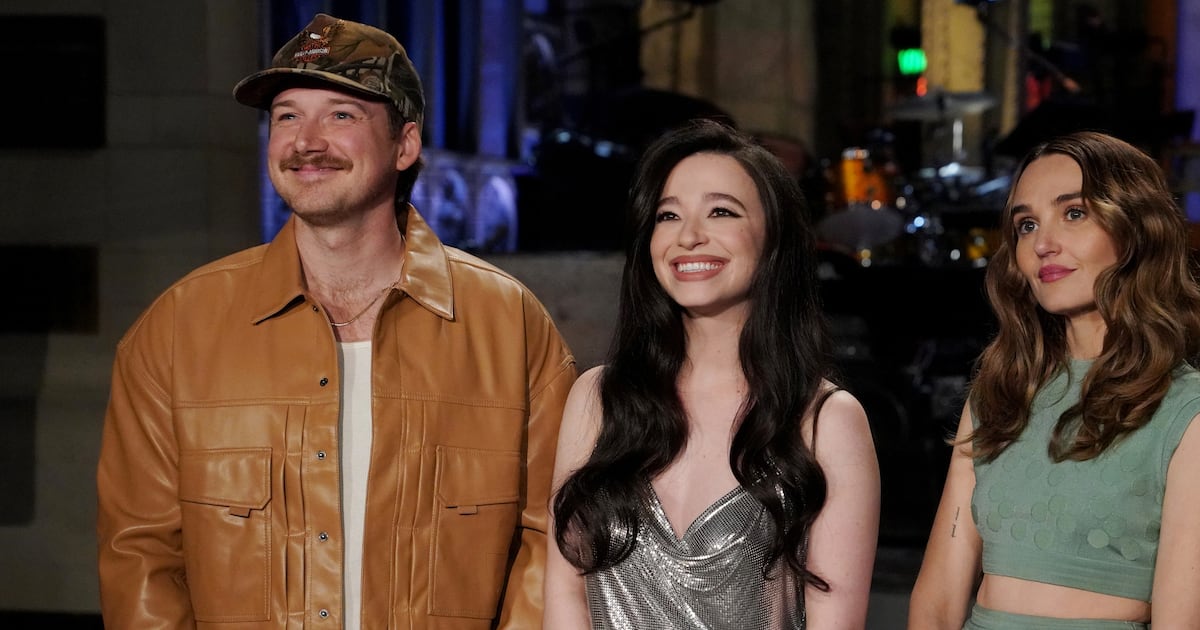There are plenty of beautiful things to admire in director Ira Sachs’ latest film, Passages (now in theaters). The movie—about two men, Tomas (Franz Rogowski) and Martin (Ben Whishaw), whose marriage dissolves when one of them begins a passionate affair with a woman named Agathe (Adèle Exarchopoulos)—is the sort of stereotypically French fare that you might find if you stumbled into an indie movie house on a Sunday afternoon. It’s filled with sexy, highly emotional people who casually betray each other in dimly lit bars, gorgeous loft apartments across various Parisian arrondissements, and even a country cottage pied-à-terre outside the city. Never mind that Sachs hails from Tennessee; on an atmospheric level alone, he’s tapped into all the right hallmarks of a sensual, sad French drama.
But even with all those pretty people and all of those exquisite locations, I’ve been unable to stop thinking about its most captivating visual aspect: Rogowski’s wildly titillating wardrobe.
Passages is a movie filled to the brim with eye-catching objects at nearly every turn, but there is none more striking than the costumes Rogowski’s Tomas wears. On first watch, one may think that Tomas’ clothing is simply a representation of the character’s visual flair, and that’s certainly true to some degree; Tomas is a film director who prides himself on detail. But a deeper look at Rogowski’s costuming, and how it’s used within the context of the film’s twisty narrative, reveals his character’s monstrous motivations and narcissism. It’s one of the most deceptively calculated (and frankly, absolutely erotic) wardrobes in any film this year.
[Some light spoilers for Passages ahead.]
You may be fooled into thinking otherwise from Passages’ opening scene. At the last shoot day for his latest film, Tomas wears a basic black hoodie and some casual gray slacks. It’s hardly the outfit of a burgeoning style icon. But later that night, at the film’s wrap party, Tomas has shed his hoodie for a form-fitting, black knitwear top, which is loosely constructed to appear sheer through the many holes in its fabric. It’s a confident choice, one that accentuates Rogowski’s slender frame and taut musculature—and Agathe, who arrives at the wrap party as friend of one of Tomas’ interns, can’t help but keep her eyes from falling on it while things heat up between them on the dance floor. A choice like this sweater tells Agathe everything it needs to about Tomas, without him having to say a word over the pulsating music.
Eventually, the pair wind up back at Tomas’ intern Erica’s apartment, where the party continues. Both dance-floor darlings find themselves alone in the kitchen, where it becomes clear that the lustful aura surrounding them isn’t merely an effect of the booze. They move to a bedroom and kiss, before Agathe removes Tomas’ sweater, stripping the thin layer of clothing that separated them all night and seeing the body that she had only been able to imagine through a dark silhouette of skin. Like dozens of other moments in Passages, it’s as positively carnal for the viewer as it is for Agathe.

Franz Rogowski and Adèle Exarchopoulos.
SBS Productions/MubiCostume designer Khadija Zeggaï worked closely with Sachs during the production to find what outfits, colors, and shapes would best reflect a character’s intentions in each scene. In conversation with Sachs for Platform, a brand that collaborates with artists who work in different mediums, Zeggaï said that Tomas’ signature colors were drawn from that of German filmmaker Rainer Werner Fassbinder, whose colorful expressionist films made him a revered mononym in the world of cinema. In fact, the sheer knit sweater is Tomas’ darkest item of clothing in the entire film. Following his first sexual encounter with Agathe, Tomas’ eccentricities (and many emotional deficiencies) explode through the color, construction, and fit of his clothing.
Take Tomas’ dragon-printed sheer crop top, which has become perhaps the most notorious of Tomas’ outfits. This top appears in two different scenes in the film, and not only does its reappearance make the film feel more human and relatable, but it also conveys something different both times it appears onscreen. After Agathe and Tomas’ first night together, Tomas has begun to irreparably crack the foundation of his relationship with Martin. But how his choices affect his husband is of little concern to Tomas, who continues the dance of entanglement with Agathe at his studio a few days after their initial tryst.
Once again, the transparency of the sheer fabric conveys Tomas’ innate sexuality without him having to say a word. It’s the kind of clothing item that’s so impossibly alluring that you’d ask a partner to keep it on during sex, which is exactly what Tomas does while he and Agathe screw on the couch. Later in the film—after Tomas and Martin break up and Tomas begins living with Agathe—Tomas wears the same top with leopard print corduroy pants to visit Martin and discuss whether or not to sell their country house. Showing up to your estranged husband’s flat with your nipples clearly visible under a thin piece of rayon fabric that accentuates the curvature of your pecs is certainly one way to ensure you’ll get what you want.
Tomas and Martin then engage in the best sex scene of any film this year, one that essentially got the film slapped with an NC-17 rating by the (allegedly!) homophobic nerds at the MPA, resulting in the film being released in theaters unrated. You never see a single sex organ in the scene, but it’s still hotter than most actual porn, and their lovemaking is baited by Tomas’ clothes as much as it is his arrogant confidence. That’s the power of Tomas’ wardrobe; it’s meant to tease and tantalize in some moments, while communicating a sort of wholesome domesticity in others. Tomas’ ability to weave between these two phenomena—sex and love—using his clothing is what makes him such a deceivingly nefarious character.
Many of Zeggaï’s costume choices—like the dragon crop top and a seafoam green sweater (again, sheer) that Tomas wears in the middle of the film—were pulled straight from her own closet. “This sweater, I had it for years,” she told Sachs in their Platform conversation. “The crop top is a girl’s crop top. At first I bought it thinking it was somewhat particular, and you told me Franz should wear it—I thought it was an audacious and interesting idea.”
That a large portion of Tomas’ wardrobe consists of smaller finds from Zeggaï’s own collection gives him a uniquely approachable quality. The character is magnetic, able to lure anyone into his destruction with only an outfit and a coy smirk. Tomas’ sexuality is as fluid as his gender-transcendent wardrobe, and that wanton, irresistible sexuality is what makes Passages’ narrative arc so affecting.
Tomas is charming and undeniably seductive; he’s the kind of person you’d ensnare yourself with even if it’s clear from their smug confidence that they’ll ultimately hurt you. Rogowski fits into this mold—and all of Zeggaï's stunning selections—effortlessly. Both the actor and the costumes work in tandem to conjure one of art cinema’s most deliciously intoxicating villains in recent memory. But even as ostentatious as the wardrobe may be, Sachs’ direction and Rogowski’s performance remain understated. It’s that push and pull between flamboyance and soft restraint that makes this troubled triad’s story (and Tomas’ fate) feel like a staggering blow to the heart, one that’s destined to end up on as many year-end lists as it does outfit inspo blogs.






